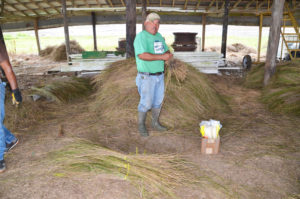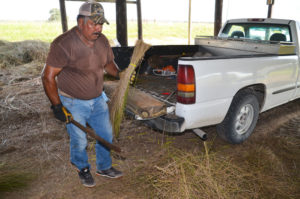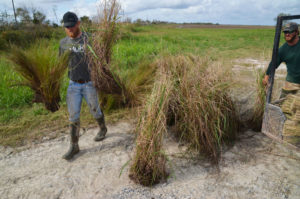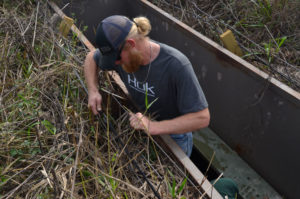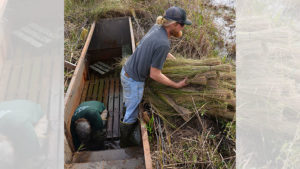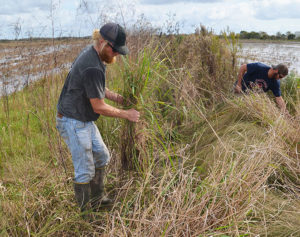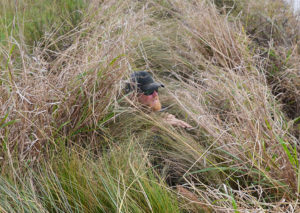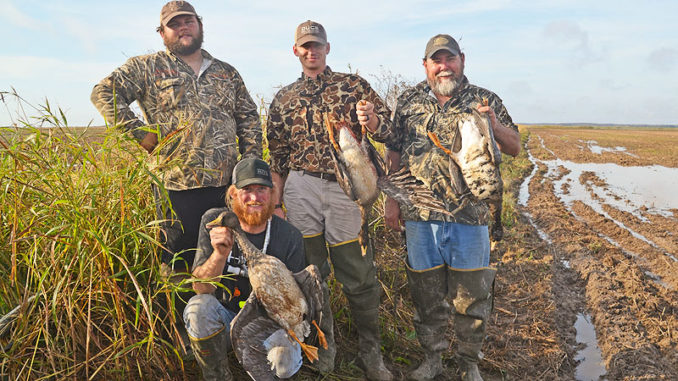
Southwest Louisiana is the epicenter for specklebelly goose hunting in the state, and some champion callers and seasoned hunters share their tips to make you more successful.
“Hey Jerald, I have some folks that you are really going to want to talk to,” the voice on the other end of the line said. “It’s about specklebellies.”
It was Cade Eskridge, the owner of Duce Rods LLC, builder of high-end fishing rods for speckled trout, redfish and largemouth bass. But this call wasn’t about fishing, but greater white-fronted geese, better known as specklebelly geese or just plain “specks.”
Eskridge has two passions: his rods, and fishing and hunting specklebellies. “I call these guys ‘the Riceland Boys’ — the best in the business.”
The day before we hunted, Eskridge had arranged for the group to meet around a big table in the Riceland Custom Calls shop in Hayes.
Perspectives
Eskridge, as the organizer of the round table, opened the discussion. “South Louisiana has the best specklebelly callers and hunters in the world,” he said. Bill Daniels quickly refined the statement, “The area from Kaplan to Lake Charles — an area 100 miles long and 4 miles wide.”
Lee Daughdrill agreed: Southwest Louisiana is the epicenter of specklebelly hunting.
“In the past, specklebellies have mostly been hunted in Louisiana, Texas and California,” said Daniels. “Now we have specklebelly hunters throughout the Mississippi, Central and Pacific Flyways. Where they wintered used to be more localized. Now it’s the fastest growing segment of waterfowl hunting.”
“That means,” said Michael Miller, “that the birds are a lot smarter than they used to be. They are being educated; they are being pressured. And on top of that we have a lot less birds than we used to in Louisiana.”
Daniels spoke again. “The number of birds in Louisiana has declined dramatically since the mid-90s. I’m basing this on information from Louisiana Department of Wildlife and Fisheries biologists.”
“We have fewer birds in Louisiana,” agreed Eskridge, “and they are being hunted by the best of the best, and every year they are getting harder to kill, in my opinion.”
Heads nodded all around the table in agreement.
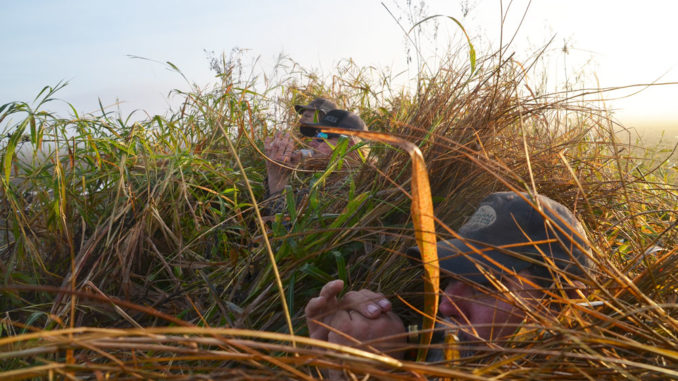
Refining specklebelly hunting
It’s an arms race: The birds get smarter. The hunters get better. So the birds get smarter. The point that waterfowl are a lot smarter than most people realize was brought home some years ago.
When spinning wing decoys entered the hunting scene, it was like hunters dropped a nuclear bomb. Ducks ate it up. It made them dumb.
Some hunters (and biologists) fretted that the new technology might be too effective. The birds would never learn, at least in time, and increased kills would endanger continental duck populations.
But learn they did. Many duck hunters now feel that the motion decoys hurt as much as help their hunting success.
As specklebelly geese have experienced more pressure throughout the length of the flyways, they too have become smarter, leaving less and less room for hunter error or carelessness.
The assembled roundtable discussed how hunters can improve their success.
Concealment
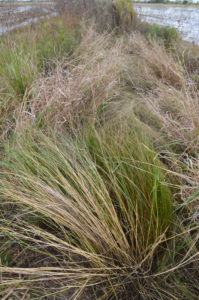
“Perfect concealment wasn’t as critical 30 years ago as now,” said Daniels. “The top of the blind could be open. Not now.
“The biggest thing over here now is brushing your goose blind overhead,” concurred Eskridge.
“Not hiding your bike properly will also affect the hunt,” added Daughdrill. “Same with the dog. And no bags on the levee; no cooler on the levee.” (Waterfowl blinds in rice fields are constructed on interior field levees built to control water.)
“It’s best, when possible, not to drive your bike in the field because it leaves tracks. Leave no imprint that you were there.”
“Something that’s important is to communicate to landowners and farmers to leave levees as natural as possible,” stressed Miller. “If they burn, mow or plow them down, your blind just sticks out.”
“I want my blind to be better than the next guy’s,” grunted Grant Henning. “Geese see so many blinds in a day.”
Calling
Daughdrill opened the discussion about calling. “Specklebelly geese are less responsive to calling then they were 10 years ago.”
“….five years ago,” Daniels upped the ante.
“Four years ago,” Henning jumped in.
“You have to finesse them now,” said Daughdrill. “And you can’t make a mistake,” added Henning. “Right,” agreed Daughdrill. “One mistake and they are gone.”
“The calling does need to be better nowadays than 10 years ago,” agreed Daniels, the veteran call-maker. “Now with YouTube and Facebook, anyone can click on a video and learn calling.
“They don’t have to spend 20 years learning by hunting. Everyone has become better callers and the geese hear it all the way down the flyway.”
“Knowing when to call and reading birds have become critical,” said Daughdrill.
“That comes with experience,” added Miller. “Yeah, you can’t just hit a button to learn that,” agreed Daughdrill.
“Just because you are a good specklebelly caller doesn’t mean that you are a good specklebelly hunter,” said Miller with a faint twinge of sarcasm.
“We are going to smaller calls, with less volume and more finesse,” said Daughdrill.
“The other calls still work,” noted Daniels, “but the smaller calls give you another weapon.
“Calling styles have changed in the last 10 years. It used to be simpler. All everybody used to do was yodel. Now you have to cluck, blow two- and three-note yodels and murmur.”
Murmuring is meant to imitate birds on the ground talking to other birds.
“Mix the three calls, doing mainly clucks and yodels, until you see what the birds are responding to, then concentrate on that.”
“If you can get it done here, you can call anywhere,” summed up Eskridge. “I go to Arkansas every year and the specks are significantly easier to call there. In Texas, guides don’t even carry a speck call. Here geese get blown at every day by great callers.”
Decoys
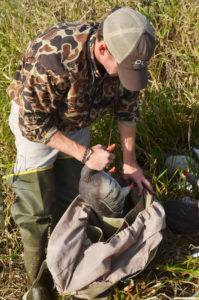
“Realism is important,” quipped Eskridge to open the discussion.
“Buy the highest-quality decoy you can afford,” urged Daniels.
“Protect the paint,” added Henning. “Use individual and slotted bags to keep the paint intact.”
“Pick them up every hunt,” instructed Miller. “If you leave them out between hunts, the birds get used to seeing them in the same place. And picking up decoys allows you to set them up with the day’s wind.
“It increases your opportunity. You only get a few chances and you want to maximize them.”
“Setting specklebelly goose decoys is entirely different than with duck hunting, where you want your decoys right in front of you,” began Daughdrill. “I put goose decoys 40 to 60 yards, even 100 yards if they are wary, from the blind.
“And set them upwind, not downwind. You are not trying to get specks to land in the decoys, but rather to go over the blind.”
“And if the birds aren’t working the way you want, you got to get out of the blind and move the decoys,” Daniels said.
“That goes to work ethic,” said Daughdrill softly.
Miller talked about decoy numbers. “When I started 10 years ago, if I had a dozen decoys, I had a bunch. By myself, I hunted with six. Now you have to have three dozen.
“That being said, late in the season, when the birds are wary, I may only use one or two (individual decoys.)”
“Decoy selection as to what mixture of sentry and feeder decoys to use is not real sensitive, except that you don’t want all sentry decoys,” opined Eskridge.
“Once the birds approach close enough for it to make a difference, it is too late for them,” agreed Daughdrill. “But I agree about not wanting all sentries. Those signify nervous birds — ones about to jump.”
Field management
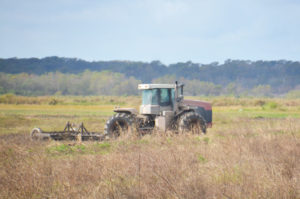
Miller began the discourse on goose field habitats by explaining that their area has three kinds of fields: soybean, rice and set-aside fields (those that farmers allow to lie fallow without a crop in alternating years as part of normal agricultural practices.)
Set-aside fields grow native annual plants such as nut grass, three-cornered grass, wild millet, wild rice and volunteer agricultural rice.
“If fields are plowed under in early summer in preparation for next year, it destroys all the natural food in the field,” he said with disgust. “The best thing to do is let the plants mature and make seeds, then plow once, rather than three or four times.
“Or you can flood the field and roll the grasses flat with a water buffalo. Back in the old days you could water buffalo a small bulls-eye around the blind.”
“Now they pick that out,” interjected Henning.
“The whole field needs to be uniform now,” agreed Miller.
“My perspective is that I prefer plowing rather than water buffaloing,” ventured Henning, which drew objection by Miller to “too much plowing.”
Rice farmers typically get two cuttings from one planting, with the second, naturally enough being called “second crop rice.” Daughdrill noted that fields with second crop rice, water buffaloing and other manipulating is limited because it is a cash crop and because of possible infringement on waterfowl baiting rules.
He went on to speak in broader terms. “You need to keep the farmers in mind when looking for a blind.”
Miller added, “There’s a whole lot of money wasted with poor communication.”
“Twenty years ago, farming was different,” Daniels stepped in.
“Now you have to work with the farmer,” finished Miller.
“Fields can also be manipulated with just water level management,” Daughdrill went on. “Drawing water levels down can cause a lot of plants to germinate. Shallow flooding can produce a lot of invertebrates.”
Hunting tactics
This is a catch-all category of short tips and suggestions. Daughdrill, not being bashful, opened first.
“We try not shooting into big groups to avoid educating a lot birds — if possible.”
“Only shoot at birds that are committed to decoys,” stressed Miller. “Don’t sky bust,” echoed Daniels and Henning. “Some hunters don’t have the ability to bring geese close enough, so they take a chance,” Daughdrill said sourly. “I would also suggest resting and rotating use of blinds if you have enough blinds.”
“Consider the use of layout blinds late in the season” suggested Miller. “Geese get used to being shot at from pit blinds and go to unused fields in late season. Camouflage them with whatever grass is in the field.”
“You have to blend in,” emphasized Daughdrill. “Don’t haul grass that doesn’t blend in from another area.
“Another thing is that sun can be a critical part of the hunt. Guides have to hunt every day, but hunters should prioritize sunny days. Specklebellies definitely commit better on a sunny day.”
A biologist’s view
Bill Daniels and Michael Miller hold a strong belief that the number of specklebelly geese overwintering in Louisiana has declined in recent years.
Paul Link, the North American Waterfowl Management Plan Coordinator for the Louisiana Department of Wildlife and Fisheries, is three years into a radio collaring project designed to study what is happening in the winter ecology of greater white-fronted geese
The table below, supplied by Link, seems to support Daniels and Miller. The abbreviation “MF” stands for “Mississippi Flyway” of which Louisiana is a part. “LA,” of course, is Louisiana.
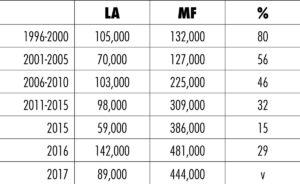 Although Link cautions that the numbers are an index rather than a counting of every individual bird, they show a very clear decline over time in the percentage of the flyway’s specklebellies that winter in Louisiana.
Although Link cautions that the numbers are an index rather than a counting of every individual bird, they show a very clear decline over time in the percentage of the flyway’s specklebellies that winter in Louisiana.
What’s not in shown in the table is the number of specks in Louisiana peaks in October now — and then declines through the hunting season.
Link feels that the trend is driven by a “big messy combination of factors.”
Agriculture has changed in Louisiana, he said. Less rice wastage occurs during harvest. Acreage devoted to rice planting has declined, with acreage in crawfish production increasing. South Louisiana has become more urbanized and industrialized.
“Eighty-five percent of our radio collar relocations last year were on agricultural lands,” he said.
Add to this the increase in waterfowl hunter numbers, which Link said have doubled in the last decade to reach an all-time high. “More hunters seem to be targeting white-fronted geese, as well,” he observed.
“And technology — now we have $250 acrylic calls, more realistic decoys, calling contests, layout blinds and better ATVs.
“Illinois, Indiana, Kentucky and Missouri are all seeing white-fronts where they never saw them before — birds that have gone back up from Louisiana. We went from wintering the majority of the mid-continent GWFG population in Louisiana to the minority.
“However, overall the population is doing incredibly well in the Mississippi Flyway.”
Bill Daniels on specklebelly calls
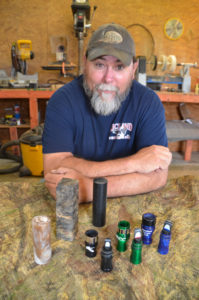
Bill Daniels makes waterfowl calls for a living, so he knows a lot about them. “It helps to carry more than one call because each day, the geese will respond to different calls in different ways.”
Riceland Custom Calls, the company he co-owns, makes three sizes of specklebelly calls. In the foreground of the accompanying photograph are their ½-inch, 5/8-inch and ¾-inch calls.
Behind them are three blanks of call material: acrylic, wood and delrin. Each will have a different tone.
Acrylic is the densest material and produces the crispest sound.
Wood, depending on the wood used, is most mellow. Riceland produces calls in cocobolo, blackwood and hedge (Osage orange) for resale in stores, but carries more than 20 types of custom wood blanks to be sold by special order.
Delrin is an extremely tough abrasion-resistant plastic made by DuPont. Its sound qualities are between acrylic and wood.
Riceland’s speck calls are typically single reed, but they will produce double-reeds on special order.
Waterfowl calls are more than a business to Daniels, probably closer to a passion.
“I will spend all day with anyone who will come to Hayes (337-884-6890) to teach them how to blow a call or how to improve their calling,” he smiled.
How to hide a blind
After the group’s big emphasis on hunter concealment, Lee Daughdrill treated me to a step-by-step viewing of how to properly camouflage a pit blind on a rice field levee.
1. Salt grass is cut by hand and strapped into bundles with wire ties.
2. One end of each bundle is cut square with a machete.
3. Switch grass clumps with roots intact are dug by hand with shovels. Both the salt grass and switch grass is taken from areas away from the blind and transported to the blind.
4. Short 2 X 4 stakes are driven around the perimeter of the pit blind. Livestock panels are split lengthways into 16-inch-wide strips with a bolt cutter. The panels are stapled to the wooden stakes (or wire-tied to driven lengths of rebar) at a 45 degree angle, inward and upward over the blind. Rubber tarp bungees are stretched in place on the outside of the wire panels all around the blind.
5. Bundles of salt grass are placed within reach of the man working inside the blind. Note the location of the wooden stakes and the livestock panel strips.
6. Working from inside the blind to preserve as much natural vegetation as possible, salt grass bundles are inserted between the stretched bungees and the livestock panels.
7. Any naturally occurring grass around the blind is folded over it. Then small holes are dug with a shovel near the perimeter of the blind and the clumps of switch grass are planted in them.
8. Daughdrill inspects the finished blind from its interior.
